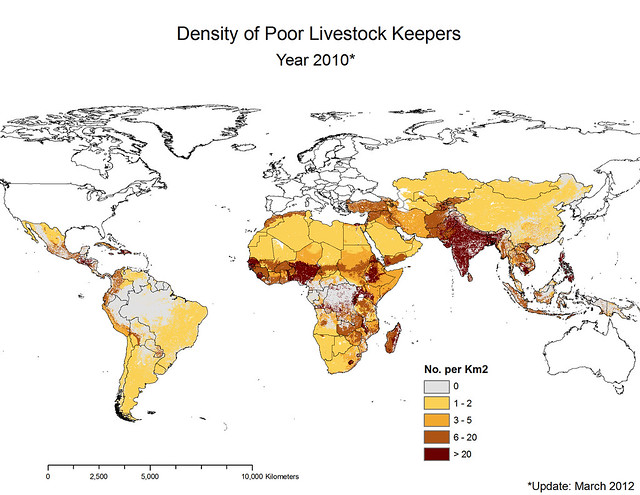One thing that I cherish about academia is the plurality of opinions and the richness of debate on any topic people care about. This is also translated into research, where facts are as quickly uncovered as they are disputed with alternative figures, making things even more complicated (as well as more interesting) with each and every study published.

Image by ILRI, via Flickr CC.
After I posted about two blogposts of the International Livestock Research Institute, which in turn were based on a paper published by Herrero et al., a colleague thoughtfully pointed out that some of the facts that were referenced may in fact be disputable. I like nothing more than a balanced discussion, so let’s have a look at both sides of the argument point by point:
- Claim: 1 billion people who survive on less than $2/day own livestock. This figures goes back to the 2009 FAO report “The State of Food and Agriculture. Livestock in the balance“, which reports: “The number of poor people who depend on livestock for their livelihoods is not known with certainty, but the most commonly cited estimate is 987 million (Livestock in Development, 1999) or about 70 percent of the world’s 1.4 billion “extreme poor”” (p.33). So this figure is actually 20 years old.
In 2005, conversely, the FAO spoke of 600 million small-scale livestock keepers in the developing world. This coincides with the 2003 work by P.K. Thornton (et al., the paper is called “Locating poor livestock keepers at the global level for research and development targeting”), who is also from the ILRI.
- Claim: More than 80% of poor Africans keep livestock. This figure is also referencing the same FAO study, although I am unsure where they got the number from exactly: the study only gives disaggregated country information, and says that in Ghana (1998), 50% of rural households owned livestock; in Madagascar (1993), it was 77%; in Malawi (2004), 63%, and in Nigeria (2004), 46% (Table 11, p. 34).
A CGIAR report (p. 391) gives the aggregate figure of 30% of poor livestock keepers on the African continent, based on 2002 data. Similarly, it cites 15% of poor South Asian livestock keepers, rather than the 40 to 66% based on the FAO.
- Claim: There are 17 billion livestock animals in the world (stated in the paper without reference). According to the Worldwatch Institute, which based their calculations on the FAOStat datasets, in 2010 at any one point in time there were 26.7 billion terrestrial farm animals (excluding aquatic livestock). In addition, my colleague pointed out that the annual turnover of raised animals is much higher than that; in fact, it has been reported that in the poultry industry alone, 68.8 billion animals were raised in 2010.
- Finally, the paper cited a 2007 report to the Intergovernmental Panel on Climate Change to argue that “the potential for the livestock sector to mitigate [its] emissions is very large (1.74 Gt CO2-eq per year)” and that the “proper management of [rangeland] … can preserve the livelihood of pastoralists”. Now, I’ve looked around the report without being able to come up with the figures they cited (though it may be due to some summing they did that I was unaware of). On the other hand, there are sources that argue that even comparatively well-managed rangelands, for example in the US, are put under increasing stress (through climate change amongst others) and that livestock might need to be eliminated to allow the land to recover.
So what does this all mean? That all the insights we arrived at last time are wrong? Not necessarily; perhaps rather, that the situation is even more complex than we thought, that it might be impossible to get perfect data, and that we should be aware of which data is being chosen in which context – since there might always be reasons for such choices, related to the argument somebody is trying to make.
Reblogged this on Science on the Land and commented:
argylesock says… Livestock in poor countries are part of a complicated story.
i am coming rather late to the debate but as the author of a report cited am happy to clarify; the ILRI report states 24 billion production animals in the world of which 17 billion are in developing countries. This is similar enough to the 27 billion terrestrial farm animals also based on FAOstats. The difference may come from using different years or because some animals (e.g. horses, donkeys) may be considered farm animals but not production animals (as not used for meat or milk). Other animals like dogs could be considered work animals but not livestock.
The 69 billion are poultry for an entire year; while the 24 billion are at any given point of time. Groilers can be produced in 42 days or 9 cycles a year. So if at a given point of time the world has 5 billion broiler poultry, this would be the equivalent of 45 billion in a year. The same issue occurs with measuring pig populations
It is complicated, and the data is poor and different studies disagree.
Thanks so much for the clarification! It is definitely complicated, and I hope there will be more data available in the future to enable a balanced debate based on values everybody can agree on 🙂